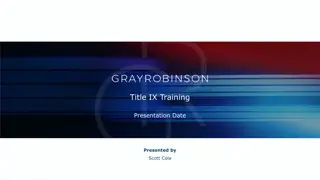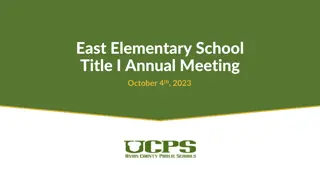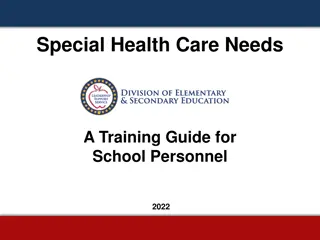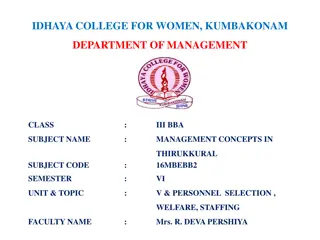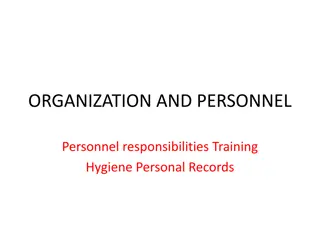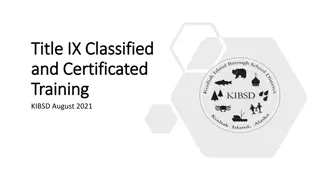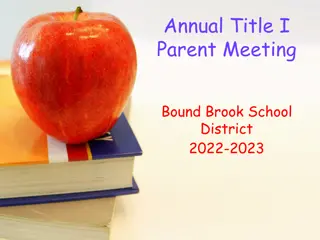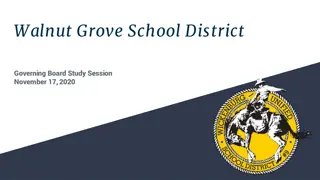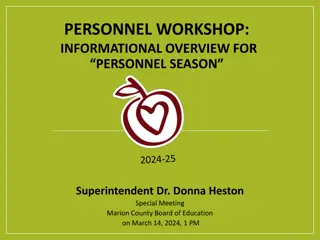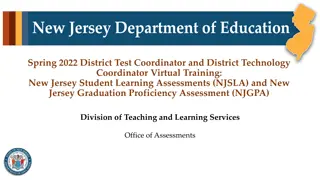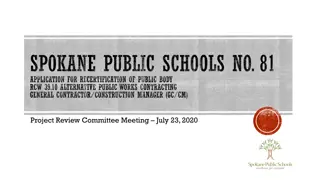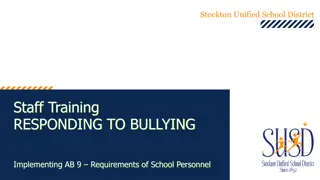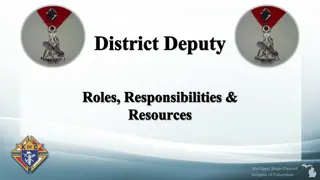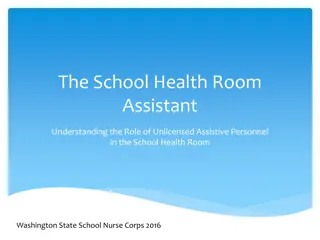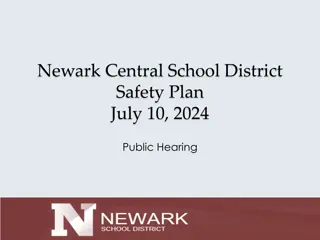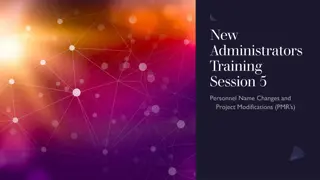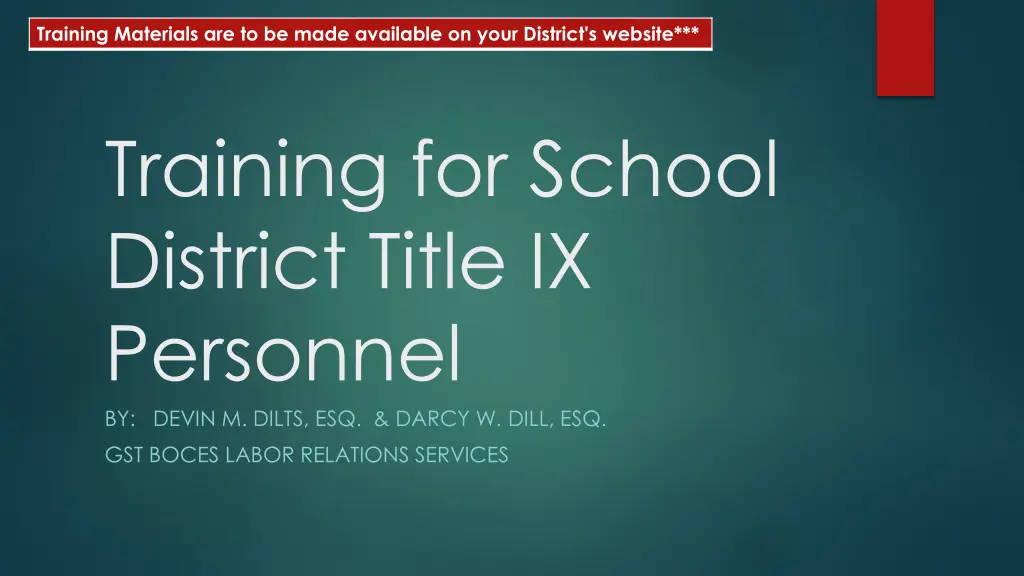
Complete Guide to Title IX Compliance in Schools
Learn about Title IX regulations, responsibilities, and key changes for ensuring compliance in educational institutions to prevent sex-based discrimination and harassment. Get insights on training materials, grievance procedures, and recent updates effective as of August 2020.
Download Presentation

Please find below an Image/Link to download the presentation.
The content on the website is provided AS IS for your information and personal use only. It may not be sold, licensed, or shared on other websites without obtaining consent from the author. If you encounter any issues during the download, it is possible that the publisher has removed the file from their server.
You are allowed to download the files provided on this website for personal or commercial use, subject to the condition that they are used lawfully. All files are the property of their respective owners.
The content on the website is provided AS IS for your information and personal use only. It may not be sold, licensed, or shared on other websites without obtaining consent from the author.
E N D
Presentation Transcript
Training Materials are to be made available on your District's website*** Training for School District Title IX Personnel BY: DEVIN M. DILTS, ESQ. & DARCY W. DILL, ESQ. GST BOCES LABOR RELATIONS SERVICES
Overview of Title IX Title IX gets its name because it was Title IX of the Education Amendments of 1972. The statute provides that: No person in the United States shall, on the basis of sex, be excluded from participation in, be denied the benefits of, or be subjected to discrimination under any education program or activity receiving Federal financial assistance. . . . 20 U.S.C. 1681(a). Title IX governs how schools respond to allegations of sexual misconduct because of a regulation mandating the adoption of grievance procedures. [2020 Regulation] 34 C.F.R. 106.8 ( Designation of coordinator, dissemination of policy, and adoption of grievance procedures. ) Adoption of grievance procedures. A recipient must adopt and publish grievance procedures that provide for the prompt and equitable resolution of student and employee complaints alleging any action that would be prohibited by this part and a grievance process that complies with 106.45 for formal complaints as defined in 106.30. A recipient must provide to persons entitled to a notification under paragraph (a) of this section notice of the recipient's grievance procedures and grievance process, including how to report or file a complaint of sex discrimination, how to report or file a formal complaint of sexual harassment, and how the recipient will respond. a) [1975 Regulation] 45 C.F.R. 86.8 ( Designation of responsible employee and adoption of grievance procedures. ): Designation of responsible employee. Each recipient shall designate at least one employee to coordinate its efforts to comply with and carry. out its responsibilities under-this part, including any investigation of any complaint communicated to such recipient alleging its noncompliance with this part or alleging any actions which would be prohibited by this part. The recipient shall notify all its students and employees of the name, office address and telephone number of the employee or employees appointed pursuant to this paragraph. a) Complaint procedure of recipient. A recipient shall adopt and publish grievance, procedures providing for prompt and equitable resolution of student and employee complaints alleging any action which would be prohibited by this part. b)
Key Changes (effective August 14, 2020 Actual Knowledge and deliberate indifference Title IX Regulations now require schools to have actual knowledge of sexual harassment before they must respond promptly in a manner that is not deliberately indifferent. A [school] is deliberately indifferent only if its response to sexual harassment is clearly unreasonable in light of the known circumstances. 34 C.F.R. 106.44(a) For our purposes, [a]ctual knowledge is defined to mean[] means notice of sexual harassment or allegations of sexual harassment to a recipient's Title IX Coordinator or . . . to any employee of an elementary and secondary school. 34 C.F.R. 106.30(a) Department of Education guidance previously stated that a school will be liable under Title IX if its students sexually harass other students if (i) a hostile environment exists in the school s programs or activities, (ii) the school knows or should have known of the harassment, and (iii) the school fails to take immediate and appropriate corrective action. Office of Civil Rights, Sexual Harassment Guidance: Harassment of Students by School Employees, Other Students, or Third Parties, 62 Fed. Reg.12033, 12039 (Mar. 13, 1997).
Changes to Title IX (continued) Option for Schools to Adopt a Different Burden of Proof Schools are not required to change the burden of proof that they are currently using preponderance of the evidence but may adopt a clear and convincing evidence standard. Regardless of which evidentiary standard a school adopts, the school must [s]tate whether the standard of evidence to be used to determine responsibility is the preponderance of the evidence standard or the clear and convincing evidence standard, apply the same standard of evidence for formal complaints against students as for formal complaints against employees, including faculty, and apply the same standard of evidence to all formal complaints of sexual harassment. . . . 34 C.F.R. 106.45(b)(1)(vii) Excludes Conduct Occurring Outside the United States (e.g., Study Abroad Programs and Off- Campus Conduct). Title IX coverage of study-abroad programs previously was unclear.
What is Sexual Harassment under Title IX? Sexual Harassment is Defined in the Regulations for the First Time For purposes of Title IX, [s]exual harassment means conduct on the basis of sex that satisfies one or more of the following: An employee of the recipient conditioning the provision of an aid, benefit, or service of the recipient on an individual's participation in unwelcome sexual conduct; 1) Unwelcome conduct determined by a reasonable person to be so severe, pervasive, and objectively offensive that it effectively denies a person equal access to the recipient's education program or activity; or 2) Sexual assault as defined in [the Clery Act], dating violence as defined in [the Violence Against Women Act ( VAWA )], domestic violence as defined in [VAWA], or stalking as defined in [VAWA]. 3) 34 C.F.R. 106.30(a).
Title IX Personnel - Mandatory Expectations How to serve impartially No conflicts of interest No bias No sex stereotypes Avoid prejudgment of facts at issue Issues of relevancy Prior sexual behavior is not relevant (Rape Shield)
Title IX Personnel and Roles Title IX Coordinator; Non-Discrimination Statement Required The recipient must notify applicants for admission and employment, students, parents or legal guardians of elementary and secondary school students, employees, and all unions or professional organizations holding collective bargaining or professional agreements with the recipient, of the name or title, office address, electronic mail address, and telephone number of the employee or employees designated as the Title IX Coordinator. . . . 34 C.F.R. 106.8(a). In addition, schools must notify those same people and groups that the school does not discriminate on the basis of sex in the education program or activity that it operates, and that it is required by title IX and this part not to discriminate in such a manner, and also must state must state that the requirement not to discriminate. . . extends to admission 34 C.F.R. 106.8(b). Any person may report sex discrimination, including sexual harassment (whether or not the person reporting is the person alleged to be the victim of conduct that could constitute sex discrimination or sexual harassment), in person, by mail, by telephone, or by e-mail, using the contact information listed for the Title IX Coordinator, or by any other means that results in the Title IX Coordinator receiving the person s verbal or written report. Publishing Title IX Coordinator Contact Information and School Non-Discrimination Statements Schools now must prominently display the name or title, office address, electronic mail address, and telephone number of the employee or employees designated as the Title IX Coordinator, and the School s notification that it does not discriminate on the basis of sex, both on the schools website, and on any handbook or catalog that it makes available to the persons or groups mentioned above. 34 C.F.R. 106.8(b)(2) Investigators and Decision-Makers The new Regulations effectively prohibit schools from using a single-investigator model, by requiring Title IX Investigators and Decision-Makers not to be the same person, or to serve as the Title IX Coordinator.
Responding to (Actual) Notice of Sexual Harassment Whether the person files a formal complaint, a Title IX Coordinator must: Offer supportive measures Advise the person of his or her right to file a formal complaint Provide the person with information about how to file a complaint.
(Non-Punitive) Supportive Measures Supportive measures are non-punitive individualized services offered as appropriate, as reasonably available, and without fee or charge to the complainant or the respondent before or after the filing of a formal complaint or where no formal complaint has been filed. 34 C.F.R. 160.3 Supportive measures restore or preserve equal access to the education program or activity without unreasonably burdening the other party, including measures designed to protect the safety of all parties or the recipient's educational environment, or deter sexual harassment. Id. Examples of supportive measures include: Counseling; deadline extensions and course adjustments; modified class schedules; escort services (likely on a college campus); mutual restrictions on contact between the parties; housing or work adjustments (again, likely in a college setting); leaves of absence or increases absence; increased security for certain areas of campus; and similar measures. Any supportive measures that a school provides to either party must be kept confidential to the extent that confidentiality does not prevent the school from effectively offering the supportive measures themselves. The Title IX Coordinator is responsible for coordinating the effective implementation of supportive measures.
Emergency Removals District can remove a Respondent from an educational program or activity, provided a risk analysis has been performed and determination made that a threat to physical safety of any student or other individual arising from alleged sexual harassment exists to justify the removal. AND The Respondent was notified and had an opportunity to challenge the decision immediately following his/her removal.
Formal Complaints Official document alleging sexual harassment Signed/filed by: - Complainant, parent or guardian - Can be signed by Title IX Coordinator even though wishes of Complainant are different. If facts are such that need to investigate so that the District is not deliberately indifferent, then the Title IX Coordinator is empowered with the authority to start the formal process Impact of filing formal complaint: Triggers grievance process
Grievance Process Generally Must be reasonably prompt to equitably resolve complaint Must follow grievance process before impose disciplinary sanctions Must be made available to staff and students Follow these Principles: Treat parties equitably Gather relevant evidence Provide supportive measures to BOTH parties Standard of Evidence selection select one (POE or CC) Presume Respondent is innocent until final determination
First Step after receipt of Formal Complaint: Start an Investigation Notice #1 goes out to BOTH complainant and Respondent Notice of grievance process Notice of alleged sexual harassment allegations and sufficient details that are known at that time Identify the parties involved in the incident Identify conduct constituting sexual harassment, the date and location Investigator will contact you soon to set up an interview Inform of any provision in the Employee/Student Code of Conduct regarding a prohibition to make false statements as part of grievance process Right to representation/advisor of his/her choosing
Investigation Appoint an investigator not the Title IX Coordinator, not the Decision Maker Notice # 2 goes out to individual parties by investigator setting up meetings. Provide notice that parties have right to representation or advisor of their choosing during questioning. ***Timing: Sufficient time for parties to prepare*** Accept all relevant evidence (inculpatory and exculpatory) - Relevant Evidence - Evidence that is pertinent to providing whether facts material to allegations are more or less likely to be true. - CAN BE: party statements, witness statements, other evidence; NOT: privileged info - Not require objective evidence /corroborating evidence - limited by requirement to complete investigation in reasonably prompt time frame Do NOT make credibility determinations Do NOT restrict right of parties to ask questions of others; to present own witnesses Parties have right to present their own evidence Parties have the right to discuss the allegations with others
Finalizing Investigation Notice #3 out to parties by investigator Advise them that investigation is near done. Provide parties with opportunity to review and respond to all relevant evidence within next ten (10) days before investigation is complete - Response is in writing Prepare Investigatory Report Send out investigatory report with statement that the parties have ten (10) days to respond to the contents of this report before the same is sent to the District s Decision Maker for his/her final determination. - Send out report simultaneously to Complainant and Respondent - Opportunity of each party to submit written questions of others after investigative report submitted, but before determination of responsibility (can be provided within same 10-day response window) District has the option to implement Due Process hearing per policy (not mandated)
Determination by Decision Maker Decision Maker must make a final written decision and finding of facts Components of Final Decision ( Determination of Responsibility ) Whether district s policies have been violated - A description of procedural steps followed - Finding of Facts - Conclusions - Rationale - Disciplinary Sanctions to Respondent or Remedy(ies) for Complainant (as applicable) - District s Title IX Procedure and Statement of Right to Appeal - You have the right to appeal the findings of this determination by following the District s Title IX appeal process located in the Board of Education Title IX policy available on our District s website. You have a right to appeal for the following reasons: a) a procedural irregularity lead to an improper outcome; b) there is new evidence that was not reasonably available previously; or c) you believe the Title IX Coordinator, investigator, or Decision Maker acting on behalf of the District had a conflict of interest or bias that affected the outcome. - Send Decision to both parties simultaneously -
Appeals & Remedies and Sanctions Only AFTER Decision Maker makes Determination of Responsibility Either party can appeal (Written Notice already provided) follow procedure with timelines established by the District If there is an affirmative determination of responsibility, implement remedies and sanctions The Title IX Coordinator is responsible for implementing such remedies and sanctions. Must make all students and staff aware of possible remedies and sanctions (policy) Remedies for the Complainant Can be individualized services like supportive measures Designed to restore and preserve equal access to education program/activity - Discipline of Respondent - Discretion left to the District
Mandatory or Permissible Dismissals If formal complaint is filed, obligation to start investigation AND provide Notice #1 (Respondent must be notified, even if complaint may be dismissed as futile ) Mandatory Dismissals Must dismiss a complaint that: Does not describe conduct that meets definition of sexual harassment Alleges sexual harassment that does not occur in the U.S. Alleges sexual harassment that did not occur in educational program/activity Permissive Dismissals May dismiss a complaint that: - Complainant wants to withdraw the formal complaint; - Respondent is not enrolled or employed by the District; or - Circumstances prevent District form gathering sufficient evidence to reach a determination about the allegations If dismiss complaint, must provide written notice to parties Rights to appeal dismissal - - -
Retaliation Prohibited; Confidentiality Retaliation Prohibited Intimidation, threats, coercion, or discrimination, including charges against an individual for code of conduct violations that do not involve sex discrimination or sexual harassment, but arise out of the same facts or circumstances as a report or complaint of sex discrimination, or a report or formal complaint of sexual harassment, for the purpose of interfering with any right or privilege secured by title IX or this part, constitutes retaliation. 34 C.F.R. 106.71(a) Confidentiality [E]xcept as may be permitted by [FERPA], or as required by law, or to carry out the purposes of [Title IX], including the conduct of any investigation, hearing, or judicial proceeding arising thereunder, schools must preserve confidentiality for: anyone who has made a report or complaint of sex discrimination (including anyone who has reported or filed a formal complaint of sexual harassment); any complainant; any individual who has been reported to be the perpetrator of sex discrimination; any respondent; and any witness. . . . 34 C.F.R. 106.71(a).
Record Keeping is Required Recordkeeping. (i) A recipient must maintain for a period of seven years records of- (A) Each sexual harassment investigation including any determination regarding responsibility and any audio or audiovisual recording or transcript required under paragraph (b)(6)(i) of this section, any disciplinary sanctions imposed on the respondent, complainant designed to restore or preserve equal access to the recipient s education program or activity; (B) Any appeal and the result therefrom; (C) Any informal resolution and the result therefrom; and (D) All materials used to train decisionmakers, and any person who facilitates an informal resolution process. A recipient must make these training materials publicly available on its website, or if the recipient does not maintain a website the recipient must make these materials available upon request for inspection by members of the public. and any remedies provided to the Title IX Coordinators, investigators,

